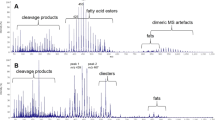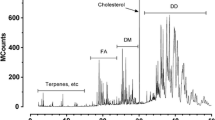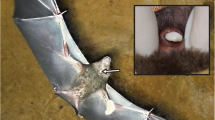Abstract
The distinctive odor ofNoctilio leporinus arises from oily secretions found beneath the wings in the subaxillary region. Analysis of secretions by gas chromatography-mass spectrometry identified 372 lipid compounds. Differences in number and chemical composition of glycolipids suggest that secretions of males from the same roost are more similar to each other than to other males or females. Differences in number and chemical composition of nonpolar lipids indicate that secretions of males are more similar to each other than to females. Since secretions differ between sexes, information on sexual identity and reproductive condition may be communicated. Individually unique lipid compositions further suggest that bats may be recognizable by their odor within the roost and while flying.
Similar content being viewed by others
References
Bradbury, J., andEmmons, L. H. 1974. Social organization of some Trinidad bats. I.Emballonuridae. Z. Tierpsychol. 36:137–183.
Brooke, A. P. 1994. Ecology of the fishing bat,Noctilio leporinus. PhD dissertation. University of Tennessee, Knoxville, Tennessee.
Brown, R. E. 1979. Mammalian social odours: A critical review.Adv. Study Mammal. Behav. 10:103–162.
Buchler, E. R. 1980 Evidence for the use of a scent post byMyotis lucifigus.J. Mammal. 61:525–528.
Davis, D. E., Herreid, C. F., II, andShort, H. L. 1962. Mexican free-tailed bats in Texas.Ecol. Monogr. 32:311–346.
Decker, D. M., Ringelberg, R., andWhite, D. C. 1992. Lipid components in anal scent sacs of three mongoose species (Helogale parvula, Crossarchus obscurus, Suricata suricatta).J. Chem. Ecol. 18:1511–1524.
Dunn, L. H. 1934. Notes on the little bulldog bat,Diras albiventer minor (Osgood), in Panama.J. Mammal. 15:89–99.
Dusenbery, D. B. 1992. Chemical ecology. W. H. Freeman, New York, 558 pp.
Ebling, F. J. 1977. Hormonal control of mammalian skin glands, p 17–22,in D. Muller-Schwarze and M. M. Mozell (eds.). Chemical Signals in Vertebrates. Plenum Press, New York, 609 pp.
Goodwin, G. G. 1928. Observations on Noctilio.J. Mammal. 9:104–113.
Goodwin, G. G., andGreenhall, A. M. 1961. A review of the bats of Trinidad and Tobago.Bull. Am. Mus. Nat. Hist. 122:187–302.
Grant, G., andBanack, S. A. 1995. Harem structure and reproductive behavior ofPteropus tonganus in American Samoa.Dept. Mar. Wild. Res. Biol. Rept. 69:1–30.
Gudger, E. W. 1945. Fisherman bats of the Caribbean region.J. Mammal. 26:1–15.
Herreid, C. F., II. 1960. Comments on the odors of bats.J. Mammal. 41:396.
Laska, M. 1990. Olfactory sensitivity to food odor components in the short-tailed fruit bats,Carollia perspicillata (Phyllostomatidae, Chiroptera).J. Comp. Physiol. A 166:395–399.
Laska, M., andSchmidt, U. 1986. Untersuchungen zur olfaktorischen Orientierung bei der Brillenblallnase,Carollia perspicillata (Chiroptera).Z. Säugetierkd. 51:129–138.
Macdonald, D. W. 1985. The carnivores: Order Carnivora, pp. 619–722,in R. E. Brown and D. W. Macdonald Social Odours in Mammals. Vol. 2. Oxford University Press, Oxford.
McCracken, G. F., andGustin, M. K. 1991. Nursing behavior in Mexican free-tailed bat maternity colonies.Ethology 89:305–321.
Nelson, J. E. 1965. Behavior of Australian Pteropodidae (megachiroptera).Anim. Behav. 13:544–575.
Ratcliff, F. N. 1932. Notes on the fruit bats (Pteropus spp.) of Australia.J. Anim. Ecol. 1:32–57.
Rohlf, F. J. 1987. Numerical Taxonomy and Multivariate Statistical Analysis for the IBM-PC. Applied Biostatistics, Inc.
Ruschi, A. 1951. Morcegos do Espirito Santo.Bol. Mus. Biol. Zool. 7:1–11.
Schmidt, U. 1985. The bats: order Chiroptera, 217–234,in (R. E. Brown and D. W. Macdonald (eds.). Social Odours in Mammals. Clarendon Press, Oxford.
Schmidt, U., andManske, U. 1973. Die jugendentwicklung der vampirfledermause (Desmodus rotundus).Z. Vergl. Physiol. 74:217–226.
Schnitzler, H., Kalko, E. K. V., Kaipf, I., andGrinnell, A. D. 1994. Fishing and echolocation behavior of the greater bulldog bat,Noctilio leporinus, in the field.Behav. Ecol. Sociobiol. 35:327–345.
Studier, E. H., andLavoie, K. H. 1984. Microbial involvement in scent production in noctilionid bats.J. Mammal. 65:711–714.
Thomas, D. W., Fenton, M. B., andBarclay, R. M. B. 1979. Social behaviour of the little brown bat,Myotis lucifigus. I. Mating behavior.Behav. Ecol. Sociobiol. 6: 129–136.
Valdivieso, D., andTamsitt, J. R. 1964. The histology of the chest gland of the pale spear-nosed bat.J. Mammal. 45:536–539.
Werner, H. J., andLay, D. M. 1963. Morphologic aspects of the chest gland of the bat,Molossus ater.J. Mammal. 44:552–555.
White, D. C., Davis, W. M., Nickely, J. S., andBobbie, R. J. 1979. Determination of the sedimentary microbial biomass by extractable lipid phosphate.Oecologia. 40:51–62.
Author information
Authors and Affiliations
Rights and permissions
About this article
Cite this article
Brooke, A.P., Decker, D.M. Lipid compounds in secretions of fishing bat,Noctilio leporinus (Chiroptera: Noctilionidae). J Chem Ecol 22, 1411–1428 (1996). https://doi.org/10.1007/BF02027721
Received:
Accepted:
Issue Date:
DOI: https://doi.org/10.1007/BF02027721




